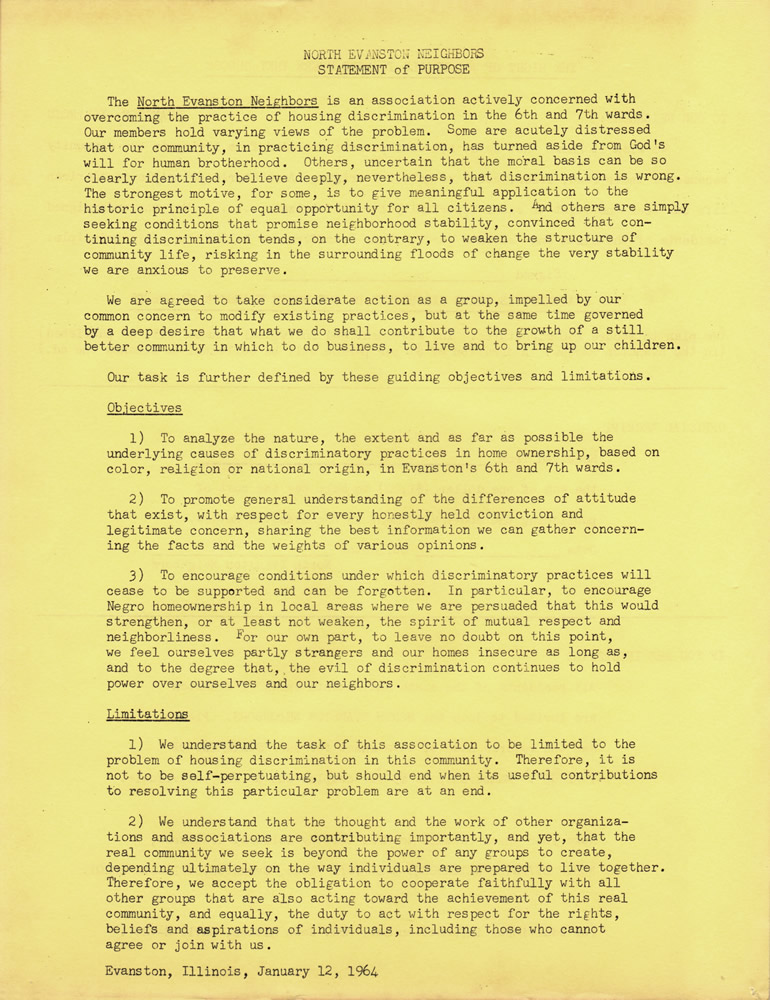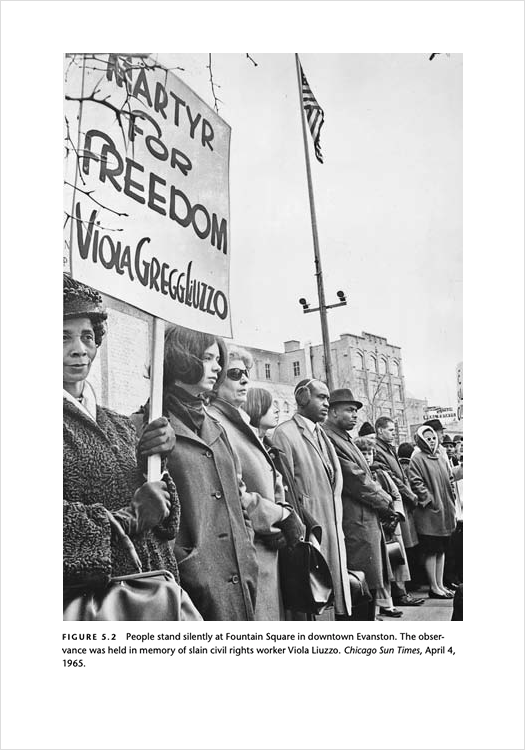 In the 1960s my father was an active member of North Evanston Neighbors (NEN), a group of residents encouraging open housing. We have a box of his papers from the group, letters and minutes, proposed ordinances. At the January meeting in 1964, a “Statement of Purpose, prepared by Dave Calhoun, was read and unanimously adopted”. There is so much of him in the words that it reads to me in his voice.
In the 1960s my father was an active member of North Evanston Neighbors (NEN), a group of residents encouraging open housing. We have a box of his papers from the group, letters and minutes, proposed ordinances. At the January meeting in 1964, a “Statement of Purpose, prepared by Dave Calhoun, was read and unanimously adopted”. There is so much of him in the words that it reads to me in his voice.
The North Evanston Neighbors is an association actively concerned with overcoming the practice of housing discrimination in the 6th and 7th wards. Our members hold varying views of the problem. Some are acutely distressed that our community, in practicing discrimination, has turned aside from God’s will for human brotherhood. Others, uncertain that the moral basis can be so clearly identified, believe deeply, nevertheless, that discrimination is wrong. The strongest motive, for some, is to give meaningful application to the historic principle of equal opportunity for all citizens. And others are simply seeking conditions that promise neighborhood stability, convinced that continuing discrimination tends, on the contrary, to weaken the structure of community life, risking in the surrounding floods of change the very stability we are anxious to preserve.
— North Evanston Neighbors, Statement of Purpose, January 12, 1964
|
There are a few strands of memory I’ve been trying to tie together from this period. Being certain of my own memories is not so important as the record these tangible documents recall; however, the fact that the memories have stayed with me might be an indication of the importance I placed in them at the time. They are at the heart of something that still needs to be voiced in the present moment.
I remember seeing Studs Terkel at some point at McGaw Memorial Hall at Northwestern. With a bit of research I’ve reconnected this memory with a civil rights rally in 1965. I would have been seven and must have gone with my father.
1,500 ATTEND CIVIL RIGHTS RALLY AT N. U.Fifteen hundred persons attended a civil rights rally in McGaw Memorial hall on the Northwestern university campus in Evanston yesterday sponsored by Northwestern University Students for Civil Rights.It marked the opening of a fund drive. Speakers included the Rev. James Bevel, field secretary of the Southern Christian Leadership conference; James Orange of Selma, Ala.; the Rev. Ralph E. Dunlop, university chaplain; and Arthur Lessing, instructor in the university’s philosophy department.The moderator was Studs Terkel, radio commentator.— Chicago Tribune, April 5, 1965source: www.newspapers.com
McGaw is more commonly used for sports events; however, soon after its completion in 1954, it held the Second Assembly of the World Council of Churches. President Dwight D. Eisenhower gave the convocation address and Robert Lowry Calhoun, (Grandpa), gave one of two keynote speeches. It’s the wooden benches I still remember that after many people giving long speeches found me bored and uncomfortable. (So much for my having a sense of the historic moment.)
James Ralph describes the rally in his book, Northern Protest: Martin Luther King, Jr., Chicago, and the Civil Rights Movement, “The triumphant march from Selma to Montgomery, Alabama, had occurred less than two weeks earlier, and as a key strategist of the Selma campaign, [Rev. James] Bevel was greeted as a hero everywhere he went. By Sunday, as he awaited his turn to speak at a rally at Northwestern University, he was an exhausted conqueror. Yet he perked up when Studs Terkel, the event’s emcee, introduced him. Known as one of the movement’s most dynamic orators, Bevel rose to his reputation. In a piercing, tense voice, he transfixed the large crowd, surprising it by talking more about racism in the North than about racism in the South.” A recording of the event is available online, Northwestern Answers Selma.
The rally kicked off the Chicago Freedom Movement that focused on fair housing. Rev. James Bevel gives a call to action for the “white women” of the North Shore with words that grate on modern ears.
There are at least 250,000 white women who have finished high school and some in college in this area who do nothing every day but sit around painting their faces and buying junk downtown, and just doing nothing… [applause] doing nothing… [applause] doing nothing. The job of the movement will be to mobilize and to motivate them to give their talents and training to help rebuild in character and strengthen people down in the South Side and the West Side.
— Rev. James Bevel, Speech: Northwestern Answers Selma, April 4, 1965
This bias is important to call out while also acknowledging the commitment of women in the movement. “Doing nothing”, members of NEN with friends rented a bus and went to Selma to march with Rev. King. This was real social action.

Mary Barr writes in Friends Disappear: The Battle for Racial Equality in Evanston about just how real — recalling the fate of Viola Liuzzo. “A white housewife from Michigan, Liuzzo had also seen television footage and gone south to volunteer. The Ku Klux Klan murdered her after the Selma to Montgomery march.” The minutes of the North Evanston Neighbors mention a vigil in observance of the tragic events of Selma.
Notice: The North Suburban Coordinating Council has scheduled a one hour silent vigil in memory of Mrs. Viola Liuzzo to be held at Fountain Square Saturday, April 3, 1:00 p.m. — North Evanston Neighbors, Minutes, March 29, 1965 |
A photo from the Sun-Times is included in Barr’s book that pictures my father among the silent witnesses.
After discovering that one of the men involved in the murder was an FBI informant, the children of Viola Liuzzo sued the government, Liuzzo v. United States, 565 F. Supp. 640 (E.D. Mich. 1983). In 1978, through the Freedom of Information Act, they had also learned that the FBI was directly involved in smearing their mother. Jack Anderson wrote in his syndicated column for March 21, 1983, at the time of the trial, “Evidently aware of the embarrassment the FBI would suffer from the presence of its undercover informant in the murderers’ car, Director J. Edgar Hoover marshalled the bureau’s resources to blacken the dead woman’s reputation.” The informant was later acquitted. Viola Liuzzo should never be forgotten and her courage and commitment endure.
![]()
Participation by NEN in the North Shore Summer Project (NSSP), part of the Chicago Freedom Movement in 1965, had been under consideration since the prior year when Rev. Emory G. Davis, pastor of Bethel A.M.E. Church, was a guest of the group. Rev. Davis “introduced a discussion of the role that could be played by this group. A new committee was established to work together with other organizations in a campaign to open Evanston apartment buildings to persons of all races.” At the Mar. 29, 1965 meeting the formal proposal to participate in NSSP was again raised. “Bill Moyer of American Friends Service Committee has worked to unify the efforts of North Shore groups working for equal housing opportunities, and the program outlined on the attached sheets has emerged. We need to decide whether NEN will be an official sponsor and we need to determine how much time our members can contribute to the program.” As a result, women of NEN took leadership roles for the project in Evanston.